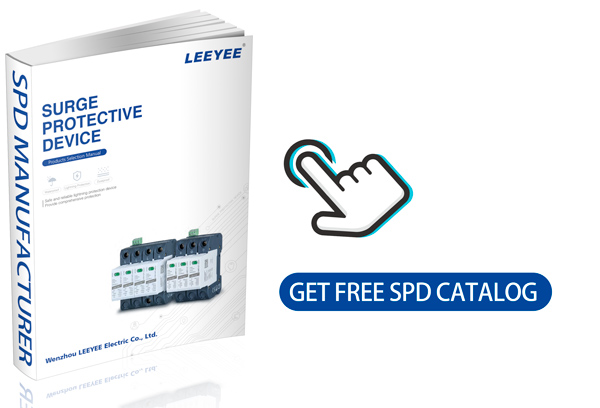One wrong connection could cause total surge protection failure.
Can you plug a surge protector into an extension cord? It may seem harmless, but this common mistake can overload circuits, reduce protection efficiency, and even increase fire risks.
LEEYEE, a global supplier in the surge protection industry, offers certified SPDs (Surge Protective Devices) for residential, commercial, and industrial use. Our products are engineered with up to 100kA discharge capacity and sub-25ns response time, compliant with UL 1449, IEC 61643-11, and CE standards.
Read on to understand the right way to install surge protectors—and what not to do.
Plugging a surge protector into an extension cord reduces its protective effectiveness, increases fire risk, and may violate electrical codes. Always connect SPDs directly to grounded wall outlets.

Still wondering why this is dangerous? Let’s dive into the technical details.
Why You Should Never Plug a Surge Protector into an Extension Cord
The Problem
Extension cords are not designed to carry sustained high current loads or handle sudden voltage surges. When a surge protector is connected through a low-grade or overloaded extension cord, the entire surge protection system becomes unreliable.
The Consequences
-
Surge energy may not reach the SPD fast enough to be clamped
-
High impedance from thin extension cords can block or distort surge response
-
Heat buildup in the extension cord can lead to melted insulation or fire
-
Voided warranties and safety certifications for the SPD
The Safer Solution
Surge protectors should be plugged directly into a wall outlet or hardwired at the main distribution panel. Installers should ensure proper grounding, cable sizing, and system load compatibility.
What the Electrical Codes Say
According to NEC Article 400 and UL 1449, surge protectors should not be connected through temporary wiring methods like power strips or extension cords. These codes require:
-
Dedicated receptacles for surge protectors
-
Short wiring distances to reduce surge impedance
-
Proper grounding (<5 ohms resistance recommended)
-
Surge device rating alignment with branch circuit fault capacity
Technical Breakdown: Why It Matters
| Aspect | Risk from Extension Cord Use | Best Practice |
|---|---|---|
| Wire Gauge | Extension cords are often 16–18 AWG (too thin) | Use 12–14 AWG minimum from wall to SPD |
| Grounding Quality | Often missing or shared grounding | SPD must connect to a verified earth ground |
| Surge Response Time | Slowed by long/high-impedance cabling | Keep cable runs under 2 feet if possible |
| Heat and Fire Risk | Overloaded cords can overheat and ignite | Use UL-listed wall circuits with correct load |
LEEYEE Surge Protector Highlights
| Feature | Specification |
|---|---|
| Maximum Discharge Current | Up to 100kA (8/20μs waveform) |
| Response Time | <25ns |
| Protection Modes | L-N, L-G, N-G |
| Operating Voltage | 120V–240V AC |
| Certifications | UL 1449, IEC 61643-11, CE, TUV |
| Indicator | LED + Remote Contact Signaling |
| Warranty | 10 years |
LEEYEE surge protectors are designed for both panel-mounted and plug-in applications, supporting sensitive equipment such as servers, medical devices, and solar inverters.
When a Surge Protector Should Be Used
✅ Best Practice:
-
Plug directly into a grounded wall outlet
-
Use panel-mounted SPD for full-circuit protection
-
Install point-of-use SPDs for electronics, AV systems, or network racks
-
Coordinate with MCB/fuse to handle short-circuit protection
❌ Avoid:
-
Using power strips with built-in surge protection as permanent solutions
-
Daisy-chaining multiple extension cords and SPDs
-
Using ungrounded outlets
FAQs – Can You Plug a Surge Protector into an Extension Cord?
1. Is it safe to plug a surge protector into an extension cord?
No. This increases impedance, reduces SPD effectiveness, and could void its certification or cause a fire hazard.
2. What does NEC say about this setup?
NEC prohibits using temporary wiring (like extension cords) to feed surge devices. Permanent, grounded connections are required.
3. What’s the risk in technical terms?
Voltage drop, high impedance, and degraded response time prevent the SPD from clamping the surge effectively.
4. Will my surge protector still work in that case?
Possibly not. It may not trigger in time or burn out if upstream protection is inadequate.
5. What are the right conditions for using an SPD?
Direct wall plug-in with verified grounding, correct breaker rating, and matching current load.
6. Is LEEYEE’s product safe for industrial environments?
Yes. We offer SPDs for DIN rail, AC panels, solar DC, and even 3-phase industrial circuits.
7. Can I get OEM versions or custom labels?
Absolutely. LEEYEE supports full customization—logo, housing, packaging, and even spec sheet branding.
⚠️ Disclaimer
This article is intended for educational and technical reference only. Surge protection devices must be selected and installed by licensed electricians following NEC, IEC, or your local electrical code. Improper installation can lead to system failure, electrical fire, or legal liability.
